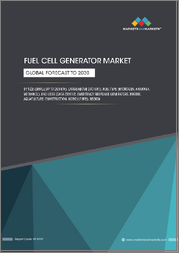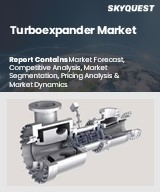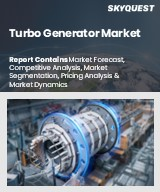
|
시장보고서
상품코드
1371870
AC 타코제너레이터 시장 예측(-2030년) : 유형별, 용도별, 최종사용자별, 지역별 세계 분석AC Tachogenerators Market Forecasts to 2030 - Global Analysis By Type ( Device Induction Tachogenerators and Synchronous Tachogenerators), By Application (Control, Measurement and Other Applications), By End User and By Geography |
||||||
Stratistics MRC에 따르면 세계의 AC 타코제너레이터 시장은 2023년에 14억 달러를 차지하며 예측 기간 중 CAGR 6.5%로 성장하며, 2030년에는 23억 달러에 달할 전망입니다.
AC 타코제너레이터는 회전 속도를 교류(AC) 전압 신호로 변환하는 전자기 장비입니다. 주로 기계 및 모터의 속도 제어 및 모니터링을 위해 다양한 산업에 적용되며, AC 타코제너레이터는 신뢰성, 단순성, 속도 측정의 정확성 등 여러 가지 장점을 가지고 있으며, AC 타코제너레이터는 견고하고 열악한 환경에서도 작동할 수 있으며, 산업 환경에 적합합니다.
신뢰도 높고 정확한 속도 측정에 대한 요구가 높아짐
AC 타코제너레이터는 정확한 속도 제어를 유지하는 것이 작업 효율과 안전에 필수적인 다양한 산업 용도에서 중요한 역할을 하며, AC 타코제너레이터는 회전 속도에 대한 실시간 피드백을 제공하여 제조, 자동차, 항공우주 등의 산업에서 기계가 지정된 매개 변수 내에서 프로세스를 최적화할 수 있도록 합니다. 가 공정을 최적화하고 기계가 지정된 매개 변수 내에서 안정적으로 작동할 수 있도록 합니다. 산업계가 더 높은 자동화와 정밀도를 추구함에 따라 속도 감지의 핵심 컴포넌트로서 AC 타코제너레이터에 대한 신뢰가 지속적으로 증가하여 시장 확대에 박차를 가하고 있습니다.
높은 유지보수 요구사항
AC 타코제너레이터는 정확한 속도 측정을 보장하기 위해 정기적인 유지보수 및 보정이 필요하며, 이로 인해 운영 비용이 증가하고 기업의 다운타임이 발생할 수 있습니다. 세척, 윤활, 마모된 부품의 교체 등 유지보수는 시간과 비용이 많이 듭니다. 이러한 측면은 특히 연속적이고 중단 없는 운영이 중요한 산업에서 부담이 될 수 있습니다. 그 결과, 기업이 속도 감지 요구에 대해 정비가 적고 비용 효율적인 대안을 찾게 되어 AC 타코제너레이터에 대한 수요를 억제하고 전체 시장 성장에 영향을 미칠 수 있습니다.
다양한 산업에서 에너지 효율적 시스템에 대한 수요 증가
지속가능성과 에너지 절약이 가장 중요한 이슈로 떠오르는 가운데, AC 타코제너레이터는 매우 중요한 역할을 할 수 있습니다. 이 장비는 회전 속도를 모니터링하고 제어할 수 있는 신뢰할 수 있는 수단을 제공하여 산업계가 기계 및 공정의 에너지 소비를 최적화할 수 있도록 하며, AC 타코제너레이터를 시스템에 통합함으로써 기업은 에너지 효율을 높이고 낭비를 줄이며 운영 비용을 절감할 수 있습니다. 수 있습니다. 그 결과, 산업계가 생산성을 유지하면서 환경 목표를 달성하기 위해 에너지 효율적인 솔루션에 대한 관심이 높아짐에 따라 이 시장은 혜택을 누릴 수 있을 것입니다.
고속 용도에서의 사용은 제한적
이러한 장비들은 항공우주, 고성능 자동차, 특정 제조 공정과 같은 산업에서 보편화되고 있는 초고속의 정확한 속도 측정에 어려움을 겪을 수 있습니다. 이러한 분야에서는 더 빠르고 정확한 속도 모니터링이 필요하기 때문에 AC 타코제너레이터는 광학 인코더 및 디지털 센서와 같은 고속 환경에 적합한 대체 기술과 경쟁할 수 있으며, AC 타코제너레이터 제조업체가 관련성과 경쟁력을 유지하기 위해서는 이러한 한계에 대응해야 합니다.에 대응하고 이러한 고속 산업에 대응하기 위해 제품 라인업을 다양화할 수 있습니다.
COVID-19의 영향 :
COVID-19의 유행은 AC 타코제너레이터 시장에 큰 영향을 미쳤습니다. 봉쇄와 공급망 중단으로 인해 세계 제조업과 산업 활동이 둔화되면서 산업기계에 일반적으로 사용되는 속도 감지 및 제어용 타코제너레이터에 대한 수요가 감소했습니다. 많은 기업이 설비 투자를 연기하거나 중단하여 타코제너레이터 판매에 영향을 미쳤습니다. 그러나 경제가 점차 회복되고 산업이 새로운 정상 상태에 적응함에 따라 자동화가 증가하고 생산성과 효율성이 강조됨에 따라 다양한 용도에서 AC 타코제너레이터 수요를 견인하여 시장이 회복될 것으로 예상됩니다.
예측기간 중 유도식 타코제너레이터 부문이 가장 큰 비중을 차지할 것으로 예상
전자기 유도의 원리를 이용하여 회전 속도를 측정하는 유도식 타코제너레이터는 다양한 산업 및 제조 용도에 필수적인 컴포넌트입니다. 유도식 타코제너레이터는 기계 및 장비 제어를 위한 정확하고 신뢰할 수 있는 속도 피드백을 제공하여 정확성과 안전성을 보장하며, COVID-19 팬데믹 기간 중 제조 산업의 혼란으로 인해 몇 가지 문제에 직면했지만, 산업 자동화 및 제어 시스템에서 그 중요성은 계속 증가하고 있습니다. 계속 증가하고 있습니다. 산업계가 효율성과 생산성에 대한 요구사항의 진화에 적응함에 따라 유도형 타코제너레이터는 여전히 필수적이며 교류 타코제너레이터 시장의 꾸준한 성장과 기술 혁신에 기여하고 있습니다.
예측 기간 중 항공우주 분야가 가장 높은 CAGR을 기록할 것으로 예상됨
예측 기간 중 가장 빠른 CAGR을 보일 것으로 예상되는 분야는 항공우주 분야로, AC 타코제너레이터는 정확한 속도 모니터링 및 제어가 안전과 성능에 필수적인 항공우주 용도에서 널리 사용되고 있습니다. 이 장비는 엔진, 랜딩 기어, 제어 시스템 등 다양한 항공기 부품에 배치되어 최적의 작동을 보장합니다. COVID-19 팬데믹 기간 중 항공우주 부문은 항공기 사용 감소와 생산 둔화라는 문제에 직면했지만, AC 타코제너레이터에 대한 장기적인 수요는 여전히 견고합니다. 여전히 견고합니다. 산업이 회복되고 기술이 계속 발전하면 AC 타코제너레이터는 항공우주 시스템의 효율성과 신뢰성을 유지하는 데 매우 중요한 역할을 하게 될 것입니다.
최대 점유율을 가진 지역 :
북미는 AC 타코제너레이터 시장에서 매우 중요한 지역입니다. 강력한 산업 기반을 갖춘 미국과 캐나다는 제조업, 항공우주산업, 자동차 산업 등 다양한 분야에서 AC 타코제너레이터에 대한 수요가 큽니다. 북미는 COVID-19 팬데믹으로 인한 초기 혼란에도 불구하고 시장 역학 변화에 빠르게 적응했습니다. 첨단 제조 기술과 산업 자동화에 대한 투자가 AC 타코제너레이터 채택에 박차를 가했습니다. 또한 이 지역은 재생 에너지원에 집중하고 있으며, 풍력 터빈 용도을 위한 타코제너레이터 수요를 주도하고 있습니다.
CAGR이 가장 높은 지역 :
아시아태평양은 AC 타코제너레이터 시장에서 중요한 위치를 차지하고 있습니다. 급속한 산업화, 제조 및 인프라 개발로 인해 중국, 인도와 같은 국가에서는 기계, 자동화 및 에너지 생산을 포함한 다양한 용도에서 AC 타코제너레이터에 대한 수요가 증가하고 있습니다. 자동화 중심의 산업이 AC 타코제너레이터 수요를 견인하고 있습니다. 또한 이 지역의 항공우주 및 자동차 산업의 확장은 이 지역 시장에서의 우수성에 더욱 기여하고 있으며, 아시아태평양을 중요한 성장 거점, 시장 확대 및 기술 혁신의 중심지로 만들고 있습니다.
무료 커스터마이즈 서비스
본 리포트를 구독하는 고객은 이하 무료 커스터마이즈 옵션 중 하나를 이용할 수 있습니다. :
- 기업 개요
- 추가 시장 기업의 종합적 프로파일링(최대 3사)
- 주요 기업의 SWOT 분석(최대 3사)
- 지역 세분화
- 고객의 관심에 부응한 주요 국가의 시장 추산·예측·CAGR(주 : 타당성 체크에 따름)
- 경쟁 벤치마킹
- 제품 포트폴리오, 지역적 입지, 전략적 제휴에 기반한 주요 기업의 벤치마킹
목차
제1장 주요 요약
제2장 서문
- 개요
- 이해관계자
- 조사 범위
- 조사 방법
- 데이터 마이닝
- 데이터 분석
- 데이터 검증
- 조사 어프로치
- 조사 소스
- 1차 조사 소스
- 2차 조사 소스
- 전제조건
제3장 시장 동향 분석
- 촉진요인
- 억제요인
- 기회
- 위협
- 애플리케이션 분석
- 최종사용자 분석
- 신흥 시장
- 신종 코로나바이러스 감염증(COVID-19)의 영향
제4장 Porter's Five Forces 분석
- 공급 기업의 교섭력
- 구매자의 교섭력
- 대체품의 위협
- 신규 진출업체의 위협
- 경쟁 기업간 경쟁 관계
제5장 세계의 AC 타코제너레이터 시장 : 유형별
- 유도 타코제너레이터
- 동기 타코제너레이터
제6장 세계의 AC 타코제너레이터 시장 : 애플리케이션별
- 컨트롤
- 측정
- 속도 규제
- 위치 결정
- 기타 용도
제7장 세계의 AC 타코제너레이터 시장 : 최종사용자별
- 자동차
- 항공우주
- 산업 자동화
- 에너지와 유틸리티
- 헬스케어
- 기타 최종사용자
제8장 세계의 AC 타코제너레이터 시장 : 지역별
- 북미
- 미국
- 캐나다
- 멕시코
- 유럽
- 독일
- 영국
- 이탈리아
- 프랑스
- 스페인
- 기타 유럽
- 아시아태평양
- 일본
- 중국
- 인도
- 호주
- 뉴질랜드
- 한국
- 기타 아시아태평양
- 남미
- 아르헨티나
- 브라질
- 칠레
- 기타 남미
- 중동 및 아프리카
- 사우디아라비아
- 아랍에미리트
- 카타르
- 남아프리카공화국
- 기타 중동 및 아프리카
제9장 주요 발전
- 계약, 파트너십, 협업, 합병사업
- 인수합병
- 신제품 발매
- 사업 확대
- 기타 주요 전략
제10장 기업 개요
- Baumer
- Dynaspede
- E. Kretzschmar
- Excella Electronics
- Kimo
- Marsh Bellofram
- Motrona
- Noris Group
- PMP Automation
- SKF
According to Stratistics MRC, the Global AC Tachogenerators Market is accounted for $1.4 billion in 2023 and is expected to reach $2.3 billion by 2030 growing at a CAGR of 6.5% during the forecast period. AC Tachogenerators are electromagnetic devices that convert rotational speed into an alternating current (AC) voltage signal. They find applications in various industries, primarily for speed control and monitoring in machinery and motors. AC tachogenerators offer several advantages, including reliability, simplicity, and accuracy in speed measurement. They are robust and can operate in harsh environments, making them suitable for industrial settings.
Market Dynamics:
Driver:
Rising need for reliable and accurate speed measurement
The devices play a crucial role in various industrial applications where maintaining accurate speed control is essential for operational efficiency and safety. AC tachogenerators provide real-time feedback on rotational speed, enabling industries like manufacturing, automotive, and aerospace to optimize processes and ensure machinery operates within specified parameters. As industries strive for greater automation and precision, the reliance on AC tachogenerators as a critical component for speed sensing continues to grow, fueling market expansion.
Restraint:
High maintenance requirements
The devices necessitate regular upkeep and calibration to ensure accurate speed measurements, leading to increased operational costs and potential downtime for businesses. Maintenance efforts, including cleaning, lubrication, and replacement of worn components, can be both time-consuming and costly. This aspect becomes especially burdensome in industries where continuous and uninterrupted operations are critical. Consequently, the demand for AC tachogenerators may be curtailed as businesses seek more low-maintenance and cost-effective alternatives for their speed sensing needs, affecting overall market growth.
Opportunity:
Increasing demand for energy-efficient systems in various industries
As sustainability and energy conservation become paramount concerns, AC tachogenerators can play a pivotal role. These devices offer a reliable means of monitoring and controlling rotational speed, enabling industries to optimize energy consumption in machinery and processes. By integrating AC tachogenerators into their systems, businesses can enhance energy efficiency, reduce waste, and lower operational costs, aligning with global efforts towards sustainability. Consequently, the market stands to benefit from the growing emphasis on energy-efficient solutions as industries seek to meet environmental goals while maintaining productivity.
Threat:
Limited use in high-speed applications
These devices may struggle to provide accurate speed measurements at extremely high speeds, which are increasingly common in industries like aerospace, high-performance automotive, and certain manufacturing processes. As these sectors demand ever-faster and more precise speed monitoring, AC tachogenerators may face competition from alternative technologies like optical encoders and digital sensors that excel in high-speed environments. To remain relevant and competitive, AC tachogenerator manufacturers need to address this limitation and potentially diversify their product offerings to cater to these high-speed industries.
COVID-19 Impact:
The COVID-19 pandemic significantly impacted the AC tachogenerators market. As global manufacturing and industrial activities slowed down due to lockdowns and supply chain disruptions, the demand for tachogenerators, which are commonly used in industrial machinery for speed sensing and control, saw a decline. Many businesses postponed or canceled capital expenditures, affecting tachogenerator sales. However, as economies gradually recover and industries adapt to the new normal, the market is expected to rebound with increased automation and a focus on productivity and efficiency, driving the demand for AC tachogenerators in various applications.
The induction tachogenerators segment is expected to be the largest during the forecast period
It is anticipated that the segment for induction tachogenerators these devices, which utilize electromagnetic induction principles to measure rotational speed, are integral components in various industrial and manufacturing applications. Induction tachogenerators provide accurate and reliable speed feedback for controlling machinery and equipment, ensuring precision and safety. While facing some challenges during the COVID-19 pandemic due to disruptions in manufacturing, their importance in industrial automation and control systems has continued to grow. As industries adapt to evolving demands for efficiency and productivity, induction tachogenerators remain indispensable, contributing to the steady growth and innovation within the AC tachogenerator market.
The aerospace segment is expected to have the highest CAGR during the forecast period
The aerospace segment is anticipated to witness the fastest CAGR growth during the forecast period. AC tachogenerators find extensive use in aerospace applications, where precise speed monitoring and control are essential for safety and performance. These devices are deployed in various aircraft components, such as engines, landing gear, and control systems, to ensure optimal operation. While the aerospace sector faced challenges during the COVID-19 pandemic, with reduced air travel and production slowdowns, the long-term demand for AC tachogenerators remains robust. As the industry rebounds and advances in technology continue, AC tachogenerators will play a pivotal role in maintaining the efficiency and reliability of aerospace systems.
Region with largest share:
North America is a pivotal region in the AC tachogenerator market. With a strong industrial base, the United States and Canada have a substantial demand for AC tachogenerators across various sectors, including manufacturing, aerospace, and automotive industries. Despite the initial pandemic-related disruptions, North America has been quick to adapt to changing market dynamics. Investments in advanced manufacturing technologies and industrial automation have spurred the adoption of AC tachogenerators. Additionally, the region's focus on renewable energy sources has driven the demand for tachogenerators in wind turbine applications.
Region with highest CAGR:
The Asia Pacific region is a significant player in the AC tachogenerator market. With rapid industrialization, manufacturing, and infrastructure development, countries like China and India have witnessed a growing demand for AC tachogenerators in various applications, including machinery, automation, and energy generation. Despite the COVID-19 pandemic's initial disruptions, the region's economic recovery and increased emphasis on industrial automation have driven the demand for AC tachogenerators. Additionally, the region's expanding aerospace and automotive industries further contribute to its prominence in the market, making Asia Pacific a key growth hub and a focal point for market expansion and innovation.
Key players in the market:
Some of the key players in AC Tachogenerators market include: Baumer, Dynaspede, E. Kretzschmar, Excella Electronics, Kimo, Marsh Bellofram, Motrona, Noris Group, PMP Automation and SKF.
Key Developments:
In June 2023, SKF signed a Virtual Power Purchase Agreement (VPPA) with Enel. The long-term agreement, forged with global energy company Enel, will enable SKF to purchase guarantees of origin from Enel's forthcoming solar project in Spain over 15 years. The purchased guarantees of origin will match the electricity consumption of about one-third of SKF's European operations in 2022.
In March 2023, KIMO welcomed the UN global agreement to protect marine biodiversity in the High Seas. After many years of negotiations, UN member states agreed a legal framework that will place 30% of the world's High Seas into Marine Protected Areas (MPAs) by 2030. The Biodiversity Beyond Natural Jurisdiction (BBNJ) Agreement, or the 'High Seas Treaty', will provide stronger protection of marine biodiversity in international waters, aiming to ensure sustainable development and to reverse biodiversity loss by mitigating the impact of climate change, pollution, shipping and overfishing.
Types Covered:
- Induction Tachogenerators
- Synchronous Tachogenerators
Applications Covered:
- Control
- Measurement
- Speed Regulation
- Positioning
- Other Applications
End Users Covered:
- Automotive
- Aerospace
- Industrial Automation
- Energy & Utilities
- Healthcare
- Other End Users
Regions Covered:
- North America
- US
- Canada
- Mexico
- Europe
- Germany
- UK
- Italy
- France
- Spain
- Rest of Europe
- Asia Pacific
- Japan
- China
- India
- Australia
- New Zealand
- South Korea
- Rest of Asia Pacific
- South America
- Argentina
- Brazil
- Chile
- Rest of South America
- Middle East & Africa
- Saudi Arabia
- UAE
- Qatar
- South Africa
- Rest of Middle East & Africa
What our report offers:
- Market share assessments for the regional and country-level segments
- Strategic recommendations for the new entrants
- Covers Market data for the years 2021, 2022, 2023, 2026, and 2030
- Market Trends (Drivers, Constraints, Opportunities, Threats, Challenges, Investment Opportunities, and recommendations)
- Strategic recommendations in key business segments based on the market estimations
- Competitive landscaping mapping the key common trends
- Company profiling with detailed strategies, financials, and recent developments
- Supply chain trends mapping the latest technological advancements
Free Customization Offerings:
All the customers of this report will be entitled to receive one of the following free customization options:
- Company Profiling
- Comprehensive profiling of additional market players (up to 3)
- SWOT Analysis of key players (up to 3)
- Regional Segmentation
- Market estimations, Forecasts and CAGR of any prominent country as per the client's interest (Note: Depends on feasibility check)
- Competitive Benchmarking
- Benchmarking of key players based on product portfolio, geographical presence, and strategic alliances
Table of Contents
1 Executive Summary
2 Preface
- 2.1 Abstract
- 2.2 Stake Holders
- 2.3 Research Scope
- 2.4 Research Methodology
- 2.4.1 Data Mining
- 2.4.2 Data Analysis
- 2.4.3 Data Validation
- 2.4.4 Research Approach
- 2.5 Research Sources
- 2.5.1 Primary Research Sources
- 2.5.2 Secondary Research Sources
- 2.5.3 Assumptions
3 Market Trend Analysis
- 3.1 Introduction
- 3.2 Drivers
- 3.3 Restraints
- 3.4 Opportunities
- 3.5 Threats
- 3.6 Application Analysis
- 3.7 End User Analysis
- 3.8 Emerging Markets
- 3.9 Impact of Covid-19
4 Porters Five Force Analysis
- 4.1 Bargaining power of suppliers
- 4.2 Bargaining power of buyers
- 4.3 Threat of substitutes
- 4.4 Threat of new entrants
- 4.5 Competitive rivalry
5 Global AC Tachogenerators Market, By Type
- 5.1 Introduction
- 5.2 Induction Tachogenerators
- 5.3 Synchronous Tachogenerators
6 Global AC Tachogenerators Market, By Application
- 6.1 Introduction
- 6.2 Control
- 6.3 Measurement
- 6.4 Speed Regulation
- 6.5 Positioning
- 6.6 Other Applications
7 Global AC Tachogenerators Market, By End User
- 7.1 Introduction
- 7.2 Automotive
- 7.3 Aerospace
- 7.4 Industrial Automation
- 7.5 Energy & Utilities
- 7.6 Healthcare
- 7.7 Other End Users
8 Global AC Tachogenerators Market, By Geography
- 8.1 Introduction
- 8.2 North America
- 8.2.1 US
- 8.2.2 Canada
- 8.2.3 Mexico
- 8.3 Europe
- 8.3.1 Germany
- 8.3.2 UK
- 8.3.3 Italy
- 8.3.4 France
- 8.3.5 Spain
- 8.3.6 Rest of Europe
- 8.4 Asia Pacific
- 8.4.1 Japan
- 8.4.2 China
- 8.4.3 India
- 8.4.4 Australia
- 8.4.5 New Zealand
- 8.4.6 South Korea
- 8.4.7 Rest of Asia Pacific
- 8.5 South America
- 8.5.1 Argentina
- 8.5.2 Brazil
- 8.5.3 Chile
- 8.5.4 Rest of South America
- 8.6 Middle East & Africa
- 8.6.1 Saudi Arabia
- 8.6.2 UAE
- 8.6.3 Qatar
- 8.6.4 South Africa
- 8.6.5 Rest of Middle East & Africa
9 Key Developments
- 9.1 Agreements, Partnerships, Collaborations and Joint Ventures
- 9.2 Acquisitions & Mergers
- 9.3 New Product Launch
- 9.4 Expansions
- 9.5 Other Key Strategies
10 Company Profiling
- 10.1 Baumer
- 10.2 Dynaspede
- 10.3 E. Kretzschmar
- 10.4 Excella Electronics
- 10.5 Kimo
- 10.6 Marsh Bellofram
- 10.7 Motrona
- 10.8 Noris Group
- 10.9 PMP Automation
- 10.10 SKF




















